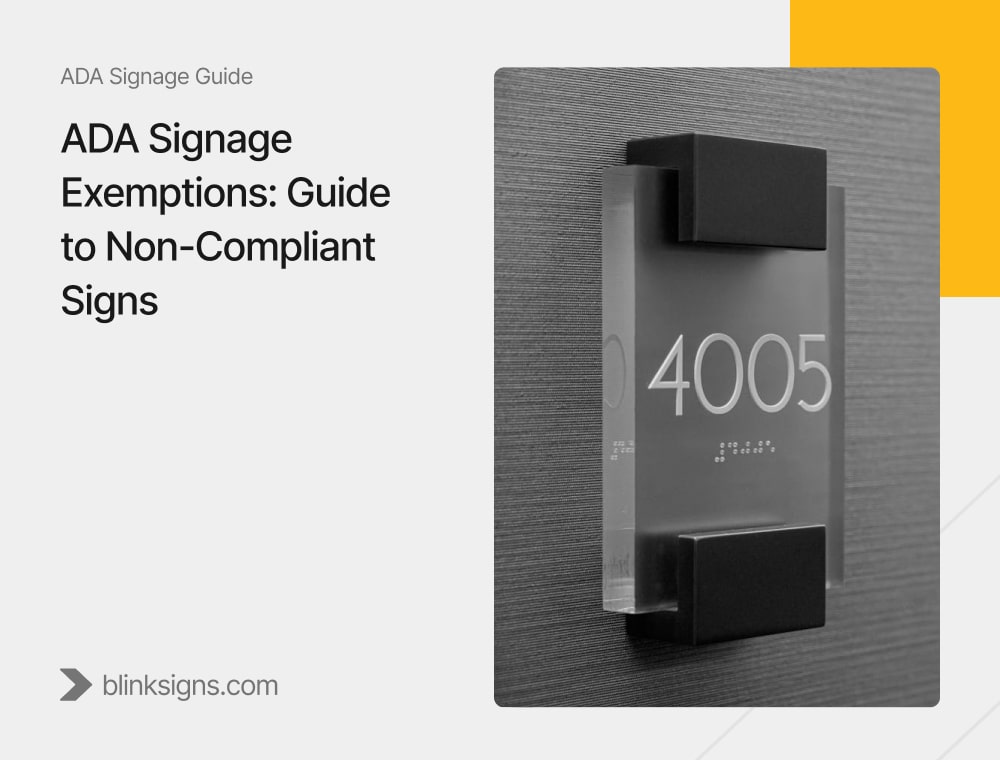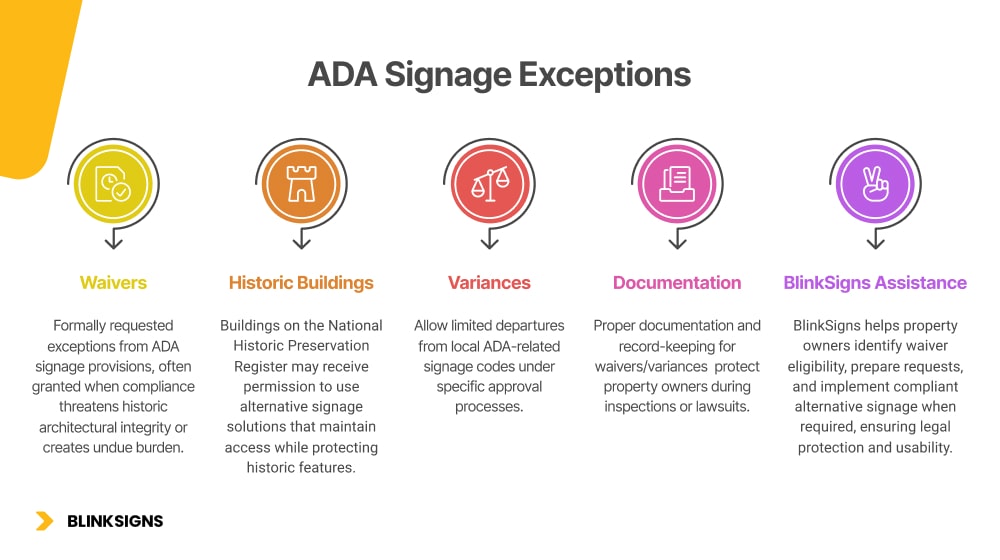
ADA Signage Exemptions: Guide to Non-Compliant Signs
Why Knowing ADA Signage Exemptions Matters
Navigating ADA signage requirements can be complex. While the Americans with Disabilities Act mandates strict signage standards to ensure accessibility, not every sign in your facility must comply. Knowing which signs are exempt helps avoid unnecessary expenses, reduces installation complexity, and mitigates legal risks.
At BlinkSigns, we bring clarity to these rules. This guide offers a definitive overview of ADA signage exemptions, helping you understand which signs do NOT require compliance, the rationale behind these exceptions, and how to apply them confidently according to federal, state, and local codes.
What Are ADA Signage Exemptions?
An ADA signage exemption means a specific sign type does not need to meet ADA requirements, such as tactile features, Braille, size, contrast, and placement guidelines. These exemptions help balance accessibility needs with practical considerations like sign purpose, permanence, and location.
While the ADA Standards provide baseline federal guidelines, some states, like California, with Title 24, and municipalities may impose stricter requirements. Therefore, always verify jurisdiction-specific rules.
Types of Signs That Are Exempt from ADA Requirements

Signs Exempt from ADA Requirements
1. Temporary Signs
- Signs posted for seven days or less (e.g., construction notices, event postings, temporary directions) are exempt.
- This recognizes the impracticality of applying tactile or Braille features to signs with limited lifespans.
2. Building Directories & Menus
- Building directories that regularly change information are exempt.
- Food and beverage menus are exempt from tactile and Braille requirements.
- This exemption acknowledges the functional difference between identification signs and informational or advertising content.
3. Occupant Names, Company Logos, and Branding
- Signs that display only company or occupant names, logos, or branding don’t require ADA tactile or Braille compliance.
- These signs serve branding rather than navigational roles.
4. Building Addresses
- Street and building address numbers are typically exempt.
- These do not function as navigational aids within the building.
5. Assembly Seating Signs
- Seat and row numbers within assembly areas like theaters and stadiums are exempt.
- Due to frequent changes and unique use cases, they are not required to meet ADA signage standards.
6. Signs in Non-Public Detention Areas
- Signs located entirely within non-public correctional or detention facility areas are exempt since these spaces are not open to the public.
7. Historic Buildings
- Buildings on the National Historic Preservation Register may qualify for alternative compliance solutions or waivers.
- ADA exemptions for historic buildings are often granted to preserve architectural features while still promoting accessibility.
Signs That Are NOT Exempt: Must Always Comply
- Identification signs that designate accessible features or spaces — restrooms, exits, entrances.
- Elevator door jamb and control button signage.
- Area of Refuge signs identifying emergency refuge spaces for persons with disabilities.
- Permanent room and space identification signs with tactile and visual characters.
- Directional and wayfinding signage that directs to accessible paths or services.
- Failure to comply with these can result in legal penalties and create barriers for people with disabilities.
State and Local Variations
While federal ADA signage exemptions establish the baseline, several states and cities impose additional rules or reduce exemptions:
- California Title 24 requires dual signage with raised pictograms and greater tactile detail.
- Texas Accessibility Standards often impose stricter placement rules and broaden signage coverage.
- Municipal codes and building departments may also mandate compliance with signs typically exempt from federal regulation.
- BlinkSigns’ experts guide clients through these nuances to ensure local compliance without overinvesting in non-required signs.
Detailed Comparison Table: ADA Signage Exemptions vs. Required Compliance
| Sign Type | Exempt Under ADA? | Description | Typical Examples | Key Notes |
| Temporary Signs | Yes | Signs posted for short periods (usually ≤7 days) | Construction notices, event signage, and temporary wayfinding | Must be clearly temporary; longer use requires compliance |
| Building Directories | Yes | Signs with changeable or general information | Tenant directories, building directories | Permanent directories with fixed info usually must comply |
| Menus and Pricing | Yes | Menus in restaurants and pricing boards | Food menus, drink lists | Not required to have Braille or tactile features |
| Occupant Names, Logos | Yes | Company or occupant names/logos | Storefront signs, business logos | Branding-only signs are exempt |
| Building Addresses | Yes | Street or address numbers | Building numbers | Do not require tactile descriptors |
| Seat and Row Numbers | Yes | Assembly seating identifiers | Theater seat numbers, stadium rows | Exempt due to frequent changes |
| Non-Public Detention Signs | Yes | Signs in private/non-public areas | Staff-only detention area signs | Accessibility rules apply to publicly accessible areas |
| Historic Building Signs | Often, with Waivers | Signs in buildings on historical registers | Plaques, alternative directional signs | Alternative compliance may be allowed; waivers required |
| Identification Signs (Restrooms, Exits) | No | Signs that identify accessible features | Restroom doors, exit signs | Must comply with tactile, Braille, and placement standards |
| Elevator Door and Control Signs | No | Signs on elevator controls and doors | Elevator buttons, jamb signs | Full compliance required |
| Area of Refuge Signs | No | Designated safe areas for emergencies | Emergency refuge areas | Must meet ADA specifications |
| Permanent Room Signs | No | Room identification signs with tactile and visual info | Offices, conference rooms | Required for accessible path compliance |
How to Determine If a Sign Is Exempt
Determining exemption status involves evaluating:
- Sign type and purpose (identification, directional, informational)
- Permanence or temporary use (7 days or less) is generally exempt.
- Location (public access vs non-public/private)
- Jurisdictional codes (federal, state, and local)
- Exemption checklist
If any answer indicates exemption, compliance standards are relax. However, due diligence via site surveys and code reviews—including consultations with BlinkSigns specialists—is recommended to avoid costly misclassification.
Waivers, Variances, and Alternative Compliance for Exemptions

ADA Signage Exemption Infographic
Some facilities, especially historic buildings or those facing undue hardship in compliance, seek waivers or variances from exact ADA signage rules.
What You Should Know:
- Waivers are formally requested exceptions from specific ADA signage provisions, often granted when compliance threatens historic architectural integrity or creates undue burden.
- Buildings on the National Historic Preservation Register may receive permission to use alternative signage solutions that maintain access while protecting historic features.
- Variances allow limited departures from local ADA-related signage codes under specific approval processes.
- Proper documentation and record-keeping for waivers/variances protect property owners during inspections or lawsuits.
- BlinkSigns helps property owners identify waiver eligibility, prepare requests, and implement compliant alternative signage when required, ensuring legal protection and usability.
FAQs
What signs don’t have to be ADA-compliant?
Temporary signs, occupant names/logos, menus, building directories, building addresses, seat/row markers, and signs in non-public detention areas are typically exempt.
Are digital or electronic signs exempt?
Temporary and frequently updated digital signs often are, but permanent ones must comply fully with ADA standards.
How do historic buildings comply with ADA signage rules?
They may qualify for waivers allowing alternative signage solutions that protect accessibility and historic features.
Are residential buildings required to have ADA signage?
Private residences do not, but common areas in multi-family housing must comply.
How can I confirm whether a sign is exempt?
Consult local codes and use professional audits; BlinkSigns offers expert compliance assessments.
BlinkSigns ADA Signage Exemption & Compliance Services
BlinkSigns offers:
- Comprehensive facility audits distinguishing compliant vs exempt signs
- Code compliance consulting tailored to federal, state, and local regulations
- Waiver and variance application assistance for historic or unique properties
- Custom-designed signage solutions that integrate required tactile/Braille features or provide compliant alternatives
- Risk assessment to avoid penalties and litigation
- Ongoing support through inspections and maintenance
Conclusion
Navigating ADA signage exemptions reduces unnecessary costs, avoids compliance pitfalls, and streamlines your facility’s accessibility planning. Having precise knowledge of which signs are exempt and when exemptions apply empowers property managers, architects, and business owners to optimize resources without sacrificing accessibility.
BlinkSigns is your trusted partner, delivering authoritative guidance and custom solutions that balance safety, usability, and compliance. Contact us today to schedule your ADA signage exemption review and compliance consultation.